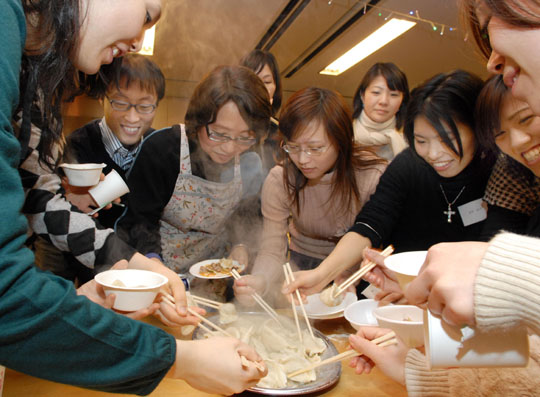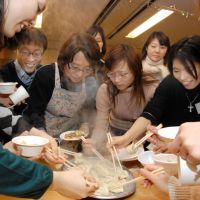Some 120 Chinese students and Japanese rolled up their sleeves and got their hands full of flour and sesame oil as part of the fun at an educational dumpling party in celebration of the Chinese New Year.
"We organized this event to have better communication and share our culture with Japanese people," said Zhong Lei, chairman of the students' association organizing the event held last month at the Tokyo International Exchange Center in Tokyo's Koto Ward.
"Making dumplings is a custom we have in northern China during Chinese New Year," said Zhong, 26, who came to Japan in 2008 as a student at the National Institute of Informatics.
Yang Hua, a 25-year-old postgraduate student at the Tokyo Institute of Technology, explained that at home in Jiling Province in northern China, people celebrate New Year's with family members at home because it's simply too cold to go out, whereas in the south, people will go to restaurants to celebrate.
Yang Hua, who also belongs to the student group said, "In my family's case, my mother and aunt start preparing food in the morning for the New Year's dinner. We also play mah-jongg," she said.
"In China, there is a television show similar to the Japanese 'Kohaku' on New Year's Eve, and I used to watch it with my family and critique all the singers."
Watching the song competition on TV while eating dumplings, or gyoza, is a common way to see in the new year, she said. "We also put a coin in one of the dumplings. It is believed that the one who gets the dumpling with the coin will become wealthy."
Zhong explained that Chinese dumplings are quite different from Japanese pan-fried gyoza. "Boiled dumplings are more common in China," he added, referring to what are known as suigyoza in Japan.
Compared to Japanese gyoza, the Chinese variety have thicker skins so that they will not fall apart during the boiling process. They also have a wide variety of ingredients but, surprisingly, do not contain garlic.
At the gyoza event, dough, made from water and flour, and ingredients such as pork with cabbage, shrimp with egg and chives, and beef with celery, were prepared at each table in the food preparation room.
With great skill, the Chinese students showed the Japanese participants how to spread the dough with a rolling pin, break off dumpling-size bits and roll them out into circles, fill them with ingredients, then fold the dough over and make pleats in the top of each dumpling.
Yang helped Japanese participants through the process. One such Japanese was Isao Hinata, 40, who came to the event with the intent of finding an employee for his company. Yang pointed out that the key to making a good circle all around before filling the dough is to keep turning the dough as it is rolled out.
"It's fun to make dumplings, but it's really difficult," said Hinata, while watching Yang expertly spread out the dough into a flat round shape. Although Hinata had lived in China before, he had yet to try his hand at making dumplings.
Makoto Netsu, a 42-year-old Japanese language teacher, and his daughter Akari, 9, had also never made Chinese-style gyoza before, but enjoyed making them with the Chinese students. "I like gyoza a lot" said Akari. Netsu said he had wanted to join the event because it looked like something children could have fun doing and also because he enjoys cooking.
While many Japanese participants struggled with rolling out the circles of dough and making the pleats, the Chinese men were quite adept. "It's common for Chinese men to cook," Yang said, the reason being that more and more women are working and couples share the housework. "Men who can't cook can't get married in China," she said laughing.
The dumpling party was organized by Odaiba Chugoku Ryugakusei Gakuyukai (Chinese Students Association) and supported by the Japan Foundation Supporters Club.
The Japan Foundation, specializing in cultural exchanges, organizes cultural events and exhibitions open to the public as well as monthly events for its Supporters Club members.



















With your current subscription plan you can comment on stories. However, before writing your first comment, please create a display name in the Profile section of your subscriber account page.